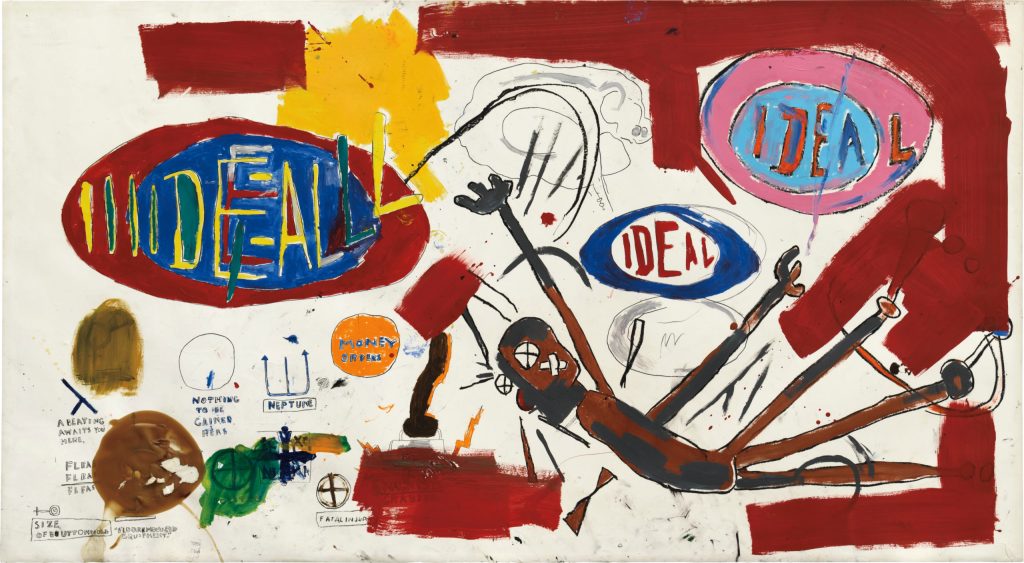[ad_1]
Jean-Michel Basquiat is poised to continue his reign at auction this summer. Alongside Joan Mitchell’s painting Noel, valued between $9.5 million to $12.5 million, Phillips will put up a key work by the artist in its New York contemporary evening sale on July 2. Standing some 6 feet by 11 feet, the monumental Victor 25448 (1987) features a host of the artist’s signature scrawls and fractured figures. The work is expected to go for between $8 million and $12 million. A percentage of the proceeds from the sale of the work will go to the Art for Justice Fund, an initiative funded in part by collector Agnes Gund that focuses on mass incarceration and art-making.
The large-scale paper on canvas work first came to the market through New York’s Tony Shafrazi Gallery, where collector Peter Brant first acquired it. The painting last came to auction when the Brants sold it in a Christie’s New York contemporary evening sale in May 2008 for $3.5 million, where it failed to meet its presale estimate of $4.5 million–$6.5 million.
“The work’s unique history, dating back to the artist’s lifetime, is a significant factor in its value,” Robert Manley, Phillips deputy chairman and worldwide co-head of 20th century and contemporary art, said in an interview.
The work was included in Basquiat’s last solo exhibition before his death in 1988, at Vrej Baghoomian gallery in New York. Before it changed hands to the current owner in 2008, the work featured in various Basquiat surveys, most recently one that stopped at the Brooklyn Museum, the Los Angeles County Museum of Art, and the Museum of Fine Arts, Houston between 2005 and 2006. The curator behind that show, Fred Hoffman, also discussed the work in his 2017 book The Art of Jean-Michel Basquiat.
The work coming up for sale is also host to Basquiat’s lexicon of sociopolitical messaging for which his works have gained renown. Victor 25448 was made the year before Basquiat’s death. The word “IDEAL,” featured prominently in the painting’s center, is a play on words, Manley said—it refers both to art dealing and dealing with punishment, and replicates the logo of the American toy brand Ideal.
“All of Basquiat’s work, directly or indirectly, expresses his identity as an Black man in a predominantly white art world,” said Manley, adding that “Victor 25448 references the brutality that Black people suffer in many forms and is also a reflection of Basquiat himself.”
According to Manley, Basquiat sourced a number of signs used in the painting from Henry Dreyfuss’s 1972 Symbol Sourcebook, a guide for graphic designers. In particular, Basquiat was thinking about “hobo signs,” which were used by homeless people to warn each other about dangerous areas. “There are a number of these used in the painting” noted Manley, who continued, “including the signs for ‘A Beating Awaits You Here’ and ’Fatal Injury,’ which seem to reference the image of the figure who has suffered some kind of brutality.” (Basquiat considered brutality and oppression in all their many forms, especially when it came to the death of graffiti artist Michael Stewart, who died from injuries sustained while in police custody after tagging a New York metro station in 1983. Basquiat’s work about the subject formed the basis for a recent exhibition at the Guggenheim Museum curated by Chaédria LaBouvier.)
Manley has a history of making market milestones for Basquiat’s works on paper, which have become a competitive corner of the artist’s market. Furious Man, from the collection of Andy Williams, sold in May 2013 at Christie’s for $5.7 million, more than quintupling its low estimate of $1 million. Several months later, in November, Head of a Madman notched $12 million at a Christie’s sale in New York.
In May 2015, Manley was also involved in the sale of an untitled Basquiat drawing from 1982 that went for $13.6 million. “His works on paper are independent from his works on canvas. They are not studies, they are standalone works,” said Manley, who continued that, with at its massive scale, Victor 25448 is a “notable exception” because most of the artist’s other works on paper are small in size. “In many ways, Basquiat was as good a draftsman as he was a painter, and you can argue that he was much more innovative in his works on paper.” And, in the wake of the Black Lives Matter protests that took place following the killing of George Floyd, the work will attest to Basquiat’s unique ability to “combine the personal, political, and universal, into one layered and nuanced whole.”
While Basquiat’s top auction records were set by artworks made in his early years, works made toward the end of his life are seeing broadened demand. “Many people still cling to this false myth that all of Basquiat’s best paintings were from 1981 to 1982,” said Manley. The top 20 most expensive works by Basquiat ever sold at auction may date back to those years, but, Manley said, “as an artist’s market matures and people start to understand the scope of an artist’s achievement, they inevitably take a broader view.”
[ad_2]
Source link


